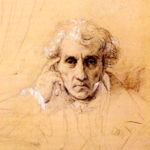Program Notes for Alchemy
 Alchemy
Alchemy
Program notes by Dr. Roger Miller
Professor Emeritus, University of Utah
To borrow a widely used musical expression, tonight’s Spring Concert covers a wide gamut. In modern English, gamut refers to the whole range or scope of something. It originated as a musical term, derived from a medieval Latin hymn honoring St. John the Baptist:
Ut queant laxis resonare fibris
Mira gestorum famuli tuorum,
Solve pollutis labiis reatum,
Sancte Iohannes.
The bolded syllables ut-re-mi-fa-sol-la represented a common six-note scale and were used as a memory device to recall interval patterns helpful in sight-reading. (For sonorous reasons ut was later replaced by the more familiar do.) To expand the scale slightly upward, Ut, was repeated at the top of the six-note scale (ut-re-mi-fa-sol-la-ut), while the Greek letter gamma represented its lowest extension. When conflated, the two syllables created the artificial word gamut.
As a means of mediating between musical concepts and actual sounds, our modern system of notation was a very clever intellectual achievement. It has been said that we can never give enough credit to the anonymous monk who thought of drawing a line to fix the position of a single pitch. From that first line, the whole system of lines and spaces (the musical staff) developed.
There has always been a certain mystique associated with writing in any form, and music is no exception. What actually constitutes the piece? Is it the sounds that temporarily bring the concept into existence, or is it the symbols that preserve the piece in written form so that it can be recreated at will, in the mind or through voices and instruments? That is a question we will explore in tonight’s program.
Alchemy
Seattle-based contemporary composer Donald Skirvin (b. 1946) is renowned for his “gorgeous” sounds and unusual color combinations. His choral song cycle Alchemy, for unaccompanied mixed chorus (SATB), on texts by Sara Teasdale, is just such a piece. Alchemy in the Middle Ages was a form of chemistry thought capable of turning ordinary metals into gold, and was embraced by such luminaries as Isaac Newton and other rational individuals. With the advent of modern science, it faded away, only to be replaced by the incredible discoveries of today’s experimental physics. The fact is that we can hardly wrap our minds around the amazing universe that surrounds us, a universe that exists as much in mathematical notation as in solid matter, perhaps even more mysterious than medieval alchemy.
The ancients thought that to name something was to bring it into existence, and, in a way, Teasdale’s poetry exploited ordinary words by turning them metaphorically into redolent images. Complementary to her texts, Skirvin’s music has been described as “rich in imagery wrought by imaginative use of harmony and apt, sensitive text-setting.” There are four individual pieces: “Living Gold,” “Cups of Fire (in a Cuban Garden),” “Jewelled Blaze (Driftwood),” and “O Beauty (August Moonrise),” juxtaposed so that each succeeding piece is to be perceived as a transformation (in an alchemistic sense) of the one preceding. Teasdale’s poetry, as represented in the four movements of Alchemy, is subject to the composer’s choices. Whenever a composer makes such choices, he does so at the peril of destroying the inherent music intended by the poet, since every poem has its own colors, rhythms, and formal design. Since these four poems were not conceived as a continuity, it must be the composer who creates an artificial unity. How well Skirvin has done that depends upon the degree that the listener can make the same all-important connections that he as a composer sees.
Skirvin has provided his own description of Alchemy:
Just as the ancient practice of alchemy endeavored to turn dross into gold, this setting of Sara Teasdale poems traces through its four movements a series of poetic and musical transformations along life’s journey; [1] grief turns into gold; [2] impermanence and the fear of loss are transformed by love; [3] a sheen of iridescence is conveyed to us by our lovers; and finally, [4] the ultimate transformation occurs when we pursue the path that beauty unfolds for us.
This piece contains many instances of jazz-based and extended chordal structures, which result in a colorful harmonic palette. One architectural detail; notice that the end of each movement sets up the beginning of the next by using the same or a related tonal enter, though the movement then migrates quickly to a new tonality: more transformations!
- “Living Gold”
In “Living Gold” Skirvin’s theme is outlined. Its reference to “spring” expresses the dual possibility of seasonal newness or beginning and the heart as a spring out of which comes both hope and despair–the twin essences of life. The yellow daisy of spring inevitably transforms into the golden leaf of autumn.
- “Cups of Fire (in a Cuban Garden)”
Poetic intent next finds expression in the vibrant colors of a tropical garden’s hibiscus and the giant ceiba tree whose tall trunk supports a welcome canopy against the sweltering sun. And that most tentative of small reptiles, the lizard, raises its head in a quizzical gesture of expectation, unaware of the black menace circling in the sky above, as a poinsettia’s scarlet petal blows away in the wind. Life is like fire — so inviting, so full of promise, yet so transient and fraught with peril.
III. “Jewelled Blaze”
So unlikely an object as burning driftwood evokes images of a seaside campfire. The poem suggests that it is not our physical selves but our memories that make us who we are. In the dancing colors of the flickering flames lies the evidence of long ago origins, both shadowy and splendorous. Is the key to the future hidden somewhere in the sea’s dark mystery?
- “Oh, Beauty”
Death is a subject that will always capture the best instincts of human imagination. In a desperate bid to rescue the spark of life from death’s darkness, Dylan Thomas pleads with the rebellious authority of a wounded warrior: “Do not go gentle into that good night. Rage, rage against the dying of the light.” Teasdale, by contrast, faces the great divide with serene resignation, inspired by the quilted softness of night falling over the New England hills. The listener has much to gain from Skirvin’s message of transformation: his seamless musical path leading from song to song, his recurring poetic images, and his skillful tone painting
Rejoice in the Lamb
The advent of Edward Elgar (1857-1953) as a truly world-class composer in the latter part of the 19th century inaugurated a new era in the history of English music. It was widely regarded as the greatest flowering of native English music since the days of Purcell. He was followed in quick succession by Ralph Vaughan Williams (1872-1958), Arnold Bax (1883-1953), William Walton (1902-1983), Benjamin Britten (1913-1976), and others, representing a line of successful composers continuing to the present. The most prolific of these was Benjamin Britten, whose many works in both instrumental and vocal media have won a permanent place in the hearts of people around the world. Rejoice in the Lamb is one of his most endearing and unusual works, described as a “Festival Cantata” for chorus, treble, alto, tenor and bass solos, and organ, on a text by the 18th-century poet Christopher Smart. The Boosey & Hawkes score explains its genesis:
It was in 1937 that the Rev. Walter Hussey, then Vicar of St. Matthew’s Church, Northampton, and later Dean of Chichester Cathedral had the idea of bringing artists and the Church back together — something extraordinary in England at that time. “How sad it was,” he said, “that the arts had become largely divorced from the Church: Sad, because artists think and meditate a lot and are in the broadest sense of the word ‘religious’. They create fine expressions of the human spirit which can symbolize and express worship, as well as conveying the truth of God to mankind in a vivid and memorable way.”
When the Rev. Hussey wanted to commission a work commemorating the 50th anniversary of the consecration of St. Matthew’s Church, he found that Britten entertained similar thoughts regarding the arts and the church and had actually been thinking about composing some kind of piece that would bring about a closer connection. By July 1943, after less than three months work, Britten had completed Rejoice in the Lamb, based on excerpts from a longer poem by Smart, the all-but-forgotten poet “in whom genius and madness were nearly together.” Smart’s poem, entitled Jubilate Agno, derived from the same text in St. John’s Revelation that Handel had used for the concluding chorus of Messiah (Rev. 5:12-13):
Worthy is the Lamb that was slain to receive power, and riches, and wisdom, and strength, and honour, and glory, and blessing. And every creature which is in heaven, and on the earth, and under the earth, and such as are in the sea, and all that are in them, heard I saying, Blessing, and honour, and glory, and power, be unto him that sitteth upon the throne, and unto the Lamb for ever and ever.
Jubilate Agno was intended as a responsive reading meant to closely parallel portions of the Order for Morning Prayer and the Psalter. He envisioned a work in which all of God’s creations — plants, animals, and even inanimate things, each in its own way — would be given a voice with which to praise the Almighty.
Smart’s texts reflected a mind of far-reaching fantasy. Unfortunately, this characteristic was seen — rightly or wrongly — as a symptom of mental instability, ultimately resulting in his being admitted to St. Luke’s Hospital for the insane in 1757, where Jubilate Agno was begun. Smart was apparently in and out of mental institutions. Nevertheless, his poem was completed four years later, on 30 January 1763. Britten was apparently attracted by the naiveté of the text. Its childlike simplicity suggested the very connection between art and religion that both he and Hussey hoped to express, if not mystically, at least symbolically. The selected texts were set by Britten in ten short sections in the form of a recitative, various solos, and choruses, as described by Hussey:
The first sets the theme. The second gives a few examples of one person after another being summoned from the pages of the Old Testament to join with some creature in praising and rejoicing in God. The third is a quiet and ecstatic Hallelujah. In the fourth section Smart takes his beloved cat as an example of nature praising God by being simply what the Creator intended it to be. The same thought is carried on in the fifth section with the illustration of the mouse. The sixth section speaks of the flowers — “the poetry of Christ.” In the seventh section Smart refers to his troubles and suffering, but even these are an occasion for praising God, for it is through Christ that he will find his deliverance. The eighth section gives four letters from an alphabet, leading to a full chorus in section nine which speaks of musical instruments and music’s praise to God. The final section repeats the Hallelujah.
Each of the Old Testament characters is linked to a creature specific to his story, such as Balaam’s ass, Daniel’s lion, David’s bear. So with the other creations, each endowed with a personality trait or characteristic unique in its ability to praise God. Perhaps the most delightful section is that of the cat Jeoffry, who, when confronted by the male Mouse defending his female, meets a worthy antagonist. In a conversation worthy of a Disney animation, the Mouse, accompanied by stoic but dignified aria, sings:
. . . If you will let her go, I will engage you, as prodigious a creature as you are.
For the Mouse is a creature of great personal valour.
Likewise the flowers. Inanimate, though they may be, the flowers “have their angels even the words of God’s Creation. For there is a language of flowers. For flowers are peculiarly the poetry of Christ.”
Even letters of the alphabet, symbolized by four selections, have unique roles to play, each chosen for some underlying or mystical value specific to itself:
- “H”–an aspirant, or breath-generated sound. (Remember that in Genesis the Spirit of God moved upon the waters, and that God breathed into Adam the breath of life.)
- “K”–a hard, penetrating sound, as in the word “King”
- “L”–a soft, mellifluent sound–symbolizing love
- “M”–natural, humming quality–symbolizing music
Lastly, Smart seems taken with Psalm 150, as he calls out “rhimes” for each type of musical instrument, suggesting that they also have a special language understood to God:
Praise ye the Lord. Praise God in his sanctuary: praise him in the firmament of his power.
Praise him for his mighty acts: praise him according to his excellent greatness.
Praise him with the sound of the trumpet: praise him with the psaltery and harp.
Praise him with the timbrel and dance: praise him with stringed instruments and organs.
Praise him upon the loud cymbals: praise him upon the high sounding cymbals.
Let every thing that hath breath praise the Lord.
Praise ye the Lord.
In short, Rejoice in the Lamb.
Neue Liebeslieder
Benjamin Britten, notoriously outspoken about composers he didn’t like, once said, “The more I hear of Brahms, the more I realize what a terrible composer he was.” “It’s not bad Brahms I mind, it’s good Brahms I can’t stand.” Brahms, who died in 1897, was long gone by the time Britten (who had admired Brahms’ symphonies as a youth) came to dislike so much of his music. However, not all of Brahms made his hit list. Among the accepted pieces were the Liebeslieder, which Britten often performed at his Aldeburgh Festival. One such performance resulted in a “sparkling recording with a starry cast . . . soprano Heather Harper, mezzo-soprano Janet Baker, Sir Peter Pears, baritone Thomas Hemsley and fellow pianist Claudio Arrau.” And no wonder — these beautifully crafted “Love-Song Waltzes,” are very easy to like. Written for vocal quartet and piano duet on unpretentious love poems by German poet and philosopher, Georg Friedrich Daumer (1800-1875), they have been called “a refined apotheosis of domestic music-making.”
There are in fact two sets of Liebeslieder. The first set (op. 52) was composed in Lichtenthal, near Baden-Baden, where Brahms was spending the summer of 1869 to be close to the Schumann family. Early in his career, Robert and Clara had befriended him, and during the course of Robert’s tortured mental decline and death in 1856, Brahms had assumed the role of family protector. A special bond developed between Brahms and Clara, resulting in some speculation that the two would marry. As time went on, however, this appeared less and less likely, and Brahms’ attention seems to have turned to the Schumann’s daughter Julie. Some have thought that this first set of Liebeslieder were the “outward expression of his current daydreams about the beautiful Julie . . . whom he was seeing every day at her mother’s house.”[1] Unfortunately, that very summer Julie had “announced her engagement to a young Italian nobleman, Count Victor Radicati di Marmorito.” Brahms, whose romantic interest had thus far been directed primarily toward Clara, seems to have been caught off guard by the turn of events. For her part, Julie almost surely viewed Brahms as nothing more than a family friend. The true nature of Brahms’ feelings, however, probably resides not far beneath the surface, in these love song lyrics:
When your eyes so gently and so fondly gaze on me,
Every last sorrow flees that once had troubled me.
This beautiful glow of our love–do not let it die!
Never will another love you as faithfully as I.
But it was to Clara, not Julie, to whom Brahms showed his first set of love-song waltzes. Clara noted her reactions in a diary entry of 16 July 1869:
At the beginning of this month Johannes brought me some charming waltzes for 4 hands and 4 voices, sometimes two and two, sometimes all four together, with very pretty words, chiefly of the folk-song type . . . . They are extraordinarily attractive (charming even without the voices) and I very much enjoy playing them.[2]
Although there was no hint, at least here, of any jealousy Clara may have felt regarding Brahms’ unspoken feelings for Julie, there was certainly enough ambiguity in the situation to warrant speculation, and this may have marked a subtle but decisive shift that would haunt Brahms for the rest of his life.
In any event, as Clara intimated, the Liebeslieder have enjoyed a life not only as vocal but also purely instrumental music, both in an arrangement for piano four-hands and a carefully reordered and orchestrated version by Brahms, himself. As David Broderick has noted, Schubert may have played an indirect role in their creation. Although Brahms was born in Hamburg, he began spending more and more time in Vienna and moved there permanently after the summer of 1869. The waltzes played an integral role in a kind of “Schubert project” that occupied Brahms for much of the 1860s. As editor of several volumes of Schubert’s unpublished Walzer and Ländler during these years, he was inspired to compose his own, including the first set of Liebeslieder in 1869. Two years later, as he considered editing a third group of Schubert dances, his imagination was once more sparked, and by 1874, the Neue Liebeslieder (op. 65) had been completed. Yet, Schubert was not his only source of attraction:
For all their Schubertian background…the two sets of vocal waltzes reflect a more contemporary source of influence as well. From time to time Brahms drew inspiration from the Waltz King himself, Johann Strauss, Jr. Thus, “Am Donaustrande, da steht ein Haus,” Op. 52, No. 9, seems indebted to the beloved “Blue Danube” Waltz, not only for its essential imagery, but perhaps for certain musical details as well.[3]
Despite their fascinating musical lineage, however, it was Daumer’s texts that defined the emotional core of the Liebeslieder, especially the second set. Daumer’s love lyrics can be traced back to Turkish folk poetry and cover a wide spectrum, leaving Brahms a number of choices, so he could have shaped the overall feeling of each set differently, if he had wanted to. In fact, it has been suggested that, whereas the first set’s cautious uncertainty unfolds in fragile innocence, the second set addresses a harsher reality: love is pain as well as beauty. Whether Brahms was still harboring disappointment over Julie Schumann or nursing his lifelong amorous frustrations, there is, in op. 65, more than a hint of unrequited love. Several authors have noted not-so-subtle changes. From a purely artistic standpoint, Malcolm MacDonald regarded the Neue Liebeslieder as slightly superior to the first set in the quality of musical thought, with the waltz idioms “ever more subordinated to individual expression” from which Brahms “seems to wring a greater depth of emotion.” Chicago Chorale annotator Bruce Tammen noted that “striking chromatic harmonies, jarring rhythms, and minor keys,” make “the music seem “darker and more passionate” and “more difficult to perform. ”
As the forms become more complicated, even Daumer’s poetry proves inadequate. For his finale, “Zum Schluss,” Brahms turns to Goethe for a suitable conclusion, expanding his waltz rhythm from a simple 3/4 to a restful (“Ruhig”) 9/4 over an extended passacaglia — F-C-B flat-A-D-C — one of his favorite compositional devices, to “calm the stormy seas of the human condition.[4]
Now, you Muses, enough!
In vain you strive to depict
how lamentation and happiness
alternate in the heart that loves.
You cannot heal the wounds
that Amor has inflicted,
but, you kind ones, relief
comes only from you.
“The Liebeslieder Walzer, in short, are quintessential Brahms. Though their charm may derive in part from the contrast in which they stand to his work as a whole, their eternal freshness stems from techniques refined in larger forms.” They tell the familiar story of an “uncompromising composer who brought the highest artistic sensibilities to every expression of his muse.” If his music does not add up to the same kind of mystical symbolism found in Britten’s Rejoice in the Lamb or Skirvin’s Alchemy, it most certainly reflects the power of music to create a whole new amalgam — an alchemy, if you will — by which Brahms expresses not only his own inner life, but the very essence of love’s anguish and joy. In this sense his music — and all great music — is not unlike the universe itself, finding ways to reveal its secrets to anyone with the sensitivity to think and to feel.
[1]Malcolm McDonald, Brahms, Master Musician Series (London: J.M. Dent and Sons, Ltd., 1990), p. 139.
[2] Seth Farwell Houston, “A cultural history of Georg Friedrich Daumer’s Polydora and Johannes Brahms’s Liebeslider waltzes, op. 52,” diss. University of Southern California, 2014.
[3] http://americansymphony.org/liebeslieder-walzer-1869/
[4] http://www.chicagochorale.org/liebeslieder-texts-g-f-daumer/
Join us for our Fine Tuning Seminar with Dr. Miller before the concert!
The seminars begin at 6:30 PM. Seats are limited, for more information, click here.



